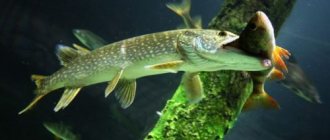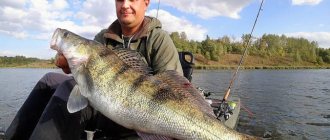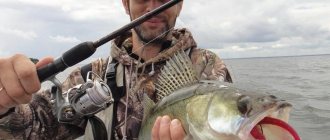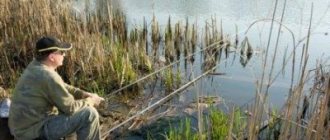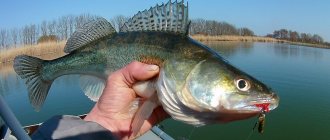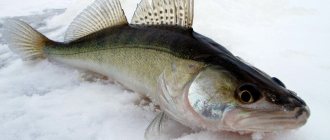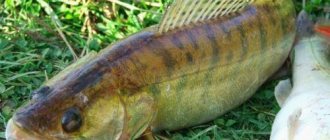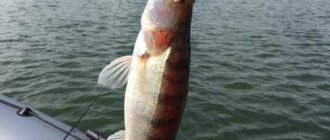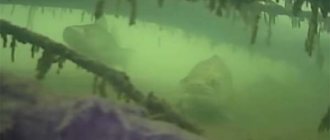Tackle for catching pike perch in open water
Pike perch lives at depth most of the time and feeds in the bottom layer of water. This behavioral feature should be taken into account when equipping gear for pike perch. After the freeze-up and throughout the entire period of open water, the following gear is used:
- Spinning;
- Feeder;
- Float rod;
- Mugs and summer girders.
Spinning for zander
When choosing a spinning rod, you need to take into account the conditions of the upcoming fishing. Models with fast or extra-fast action are suitable. With such a rod it is easier to pierce the strong jaw of a predator.
The reel is used when fishing for fish. To catch large specimens, powerful and high-quality models are installed. When choosing a spinning reel, you should pay attention to the presence of a friction clutch. A resisting pike perch on a hook can make sharp jerks. A correctly adjusted clutch releases part of the fishing line without weakening its tension.
Particular attention is paid to equipment. It is better to use a spinning cord with a load capacity of at least 10 kg. To reduce the likelihood of snagging, it is advisable to use a Tyrolean stick or Carolina rig. The weight of the equipment with bait should be within the test rod limits.
Feeder for zander
If zander trails are known, then feeder fishing is applicable. The main elements of the tackle (rod, reel, cord or fishing line) are selected in the same way as for a spinning rod. But how to equip the feeder is up to each angler to decide at his own discretion. By the way, you can do without a feeder. But it is preferable to use a feeder. A bream that happens to bite along the way won’t be a big disappointment. Large feeder feeders with large cells are used.
Bait for pike perch is prepared from chopped fresh fish or sprat. You can use waste from fish processing before cooking. You can attract pike perch with crushed beef liver or condensed blood. The required viscosity is achieved by adding bran, breadcrumbs or fishing glue. Massive washing out of the bait should begin after the feeder is lowered to the bottom.
Fishing for pike perch on the Volga
Hunting for pike perch on the Volga, like on any other large river, has its own characteristics. Fishing from the shore in such conditions can be quite a difficult task - pike perch often stands at a great distance from the shore, and you will have to try hard to get to it. It is for such rivers that spinning rods with a length of 3 meters or more are produced. They usually go to large rivers for trophy specimens, so spinning boxes often contain wobblers 130, 140 millimeters long and silicone of approximately the same size - this approach allows you to cut off the small stuff and focus on catching a trophy fanged predator. Local fishermen have noticed that in the spring, pike perch prefer wobblers of natural color; the time for acid baits will come in the summer.
What do pike perch bite on?
When choosing bait for pike perch, you should take into account the physiological characteristics of the predator. It hunts for small fish with a narrow and elongated body. The appearance of artificial baits should be the same. Lures for zander:
- Wobblers 8-10 cm long;
- Narrow oscillating spoons;
- Rotating spoons with a petal length of 5-6 cm and a width of 1-2 cm;
- Twisters and vibrotails. Jig fishing often results in a good catch;
- Silicone and foam fish;
- When fishing vertically, rattlins and fishing balancers are used.
Bait for pike perch:
- Live bait. Small fish with a narrow body are used;
- Tulka. Placed whole or in pieces;
- A bunch of worms or bloodworms.
When fishing with a float rod, you can use pellets. This attachment can also be used as bait.
Features of catching pike perch in March
Until the ice melts, winter fishing for pike perch continues on the last ice. After opening the reservoirs, the predator becomes more active. The fish continues to move along its usual winter paths above the bottom surface. Rarely found in shallow waters. It can enter the steep coastal zone in flooded quarries. Fishing for pike perch in March is carried out in those areas in which it pecked during the freeze-up period. It should be borne in mind that the activity of the predator increases at night. For catching March pike perch, long-range gear is better suited: spinning rod and feeder.
When fishing with a spinning rod, casts are made throughout the entire available sector to the maximum possible distance. The bait is held above the bottom surface. The type of wiring changes regularly.
Feeder fishing is carried out using several gears. Casts are made with a fan at different distances. The predator reliably captures the bait. When fishing for large fish, there is no need to fuss and force the fish to get to the shore. A gradual pull-up is performed with the rod, while lowering it for the next pull-up, the fishing line is selected onto the reel. The main thing is that the fishing line is always taut. Removing pike perch from the water is done with a landing net.
Selection and methods of baiting bait for catching pike perch
Pike perch has no special preference for the species of bait, except that one should take into account the structure of the jaws of this fanged predator. Pike perch has a relatively small mouth and therefore its natural prey is fry and juvenile fish with an elongated body shape. You need to try to select live bait so that it is as close as possible in appearance and size to the main prey of pike perch at the moment. In addition, it is better that the live bait continues to move in the water for as long as possible and does not fall asleep. For this purpose, fish species of “strong” breeds are suitable, that is, quite tenacious. The ideal live bait in terms of survivability are crucian carp, ruffe, and gudgeon. The most common prey for pike perch are bleak, small perch and sabrefish, juvenile roach and silver bream, other types of carp fish, as well as sprat, which enter the mouth of the Volga from the Caspian Sea in large schools. An important component of live bait tackle is the hook. Usually they use a single or double with an elongated dark-colored forearm. The size of the hook depends primarily on the size of the baitfish, the size of which in turn determines the expected size of the prey. Many inexperienced fishermen make the mistake of choosing a large number hook in anticipation of a bite from a large pike perch or pike. It is logical that a larger predator can take a larger bait, but in practice this does not always work, in addition, a large pike will take a small baitfish, but a medium-sized pike or pike perch may not dare to attack a two-hundred-gram roach. In addition, pike perch also has a small mouth. Too large hooks are difficult to attach to live bait without injuring it to the point of death, and a live, mobile fish looks much more attractive to a river predator. Therefore, it is not advisable to use large hooks and anchor tees - parts of the forend and the sting of excessively large hooks protruding from the live bait can scare off a predator or lead to snags when fishing in snags; use tees, since the presence of hard “foreign objects” can scare off even a fairly large pike perch. Tackle for catching pike perch with live bait In Trekhrechye, the confluence of Akhtuba, Kharabalyk and Mangut, there are many areas of water of various types for live bait fishing for pike perch in the spring. In April, the most promising will be riffles with underwater holes, exits from the depths onto sandbanks, and channel edges. In all cases, the most effective fishing will be near snags or flooded trees, in places where the main and reverse currents border, rip currents, and pools under riffles. They catch pike perch with live bait both from a boat and from shore - depending on this, the gear is selected. The main methods of live bait fishing for any Volga predator: - a float wire or bottom fishing rod for fishing in the current; — bottom tackle for fishing from the shore; — an onboard fishing rod for fishing with live bait from a boat; — spinning rod for active fishing for pike perch from a boat in a vertical position. The advantage of a wire rod in such a situation is obvious - with its help you can fish large areas of the water area thanks to the current. Wiring tackle is indispensable when searching for anchorages for large pike perch, in cases where the water area and bottom topography are unknown in advance. Having determined the boundaries of promising areas for stationary live bait fishing using a wire rod, you can install bottom gear. There are no special requirements for the rods, except for sufficient rigidity to be able to perform a sharp hook. The main line is a braided cord with a diameter of 0.16-0.22 mm. If you are mounting a bottom tackle with several leashes for live bait, then it is better to make it on a separate leash fastened through a swivel with bends of 10-15 cm and an end sinker weighing 50-100 grams. When catching pike perch, it is better not to use rough gear, as it can be very careful. For leashes, monofilament line with a diameter of 0.22 - 0.28 mm or fluorocarbon, which is inconspicuous in water and much more durable, is suitable, but it is significantly more expensive. Metal leashes are not needed when fishing for pike perch; moreover, they greatly reduce the mobility of live bait, worsen the play of dead fish in the current and can alert the pike perch. However, when fishing from great depths in a snag or near a channel hole, a bite may occur from a fairly large pike, which can damage a regular fishing line with its sharp gill covers. It's up to you to decide
The live bait is placed below the sliding olive sinker on a leash 40-60 cm long. You can also place the live bait on a side branch up to 1 m long above the blind end sinker. As mentioned, it is better to use single or double hooks according to the size of the bait fish. If the live bait is “vigorous” or small (sprat, bleak), it is better to use a single hook with a long shank. For dead, sluggish live bait, a rig with a double hook is used (a wire needle with a hook is threaded through the fish). The tackle is attached to a side leash about 50 cm long. In this case, the baitfish holds well, and the hooks are pressed to the body of the baitfish and do not scare off the pike perch. During the current, the fish will play as if alive and this will significantly reduce the number of empty bites.
Fishing for pike perch in April
In April, pike perch actively bites throughout the day. Increased gluttony is observed before the upcoming spawning. Pre-spawning zhor is determined by stabilizing the water temperature within +8-10 degrees. Spawning of pike perch begins after the water warms up above +11o.
Where to look for pike perch in April
It should be taken into account that the migration of pike perch to spawning grounds is hardly noticeable. Predators move to shallow water areas with a depth of 1 m or more in groups of 3-4 individuals. Usually one female is accompanied by several males. Before spawning, pike perch can be found above the bottom surface at a depth of 1.5 m. Fishing for pike perch in April can be successful in areas with the following features:
- No silt at the bottom. You should choose areas with a rocky (pebble) and sandy bottom surface;
- The mouths of tributaries, where small fish accumulate in large numbers: gudgeon, bleak, small roach, etc.;
- Slopes behind rifts;
- Slow flow areas;
- Bottom boulders or other obstacles;
- Sharp changes in depth and the presence of edges.
When moving to spawning grounds, the predator can enter shallow water areas during the daytime.
Catching pike perch in April is possible with different gear, using all available baits and lures.
Lures for zander
To catch pike perch in April, experienced fishermen advise using spinners weighing up to 40 grams (the choice depends on the depth and fishing conditions). Note that in April, pike perch can most often be found at a depth of more than five meters. The most promising areas include: rocky ridges, channel edges with a hard bottom, and exits from wintering pits.
As for wiring, the best results can be obtained when using drift wiring when fishing in strong currents or step-strike wiring. Everything is clear with the first option, let’s dwell a little on the second option. So, after casting, we allow the bait to completely sink to the bottom, after which we pause and make a short pull with the tip of the rod. It is important that the bait does not come off the bottom and constantly touches the relief, creating a cloud of turbidity. With this method of fishing, the use of a “retractable leash” equipment is suitable.
The use of stepped wiring will be especially relevant when catching pike perch at the exit from the pit. Here, not only the jig bait option is suitable as bait; a rotating spoon with a small weight in the front will work great for pike perch in April. Note that the bite mainly occurs at the moment of pause, when the bait sinks to the bottom.
When fishing at great depths and strong currents, it is more convenient to catch pike perch using drift fishing. The bait is cast a little higher upstream or across it. It is important to consider that while the artificial bait reaches the bottom, it will be carried approximately 35 degrees relative to the casting point towards the angler. When the bait reaches the bottom, several sharp jerks are made (we tear off the bait), the drift continues until it is carried to the coastline. This method of fishing is effective, but it is only possible in areas with a clean bottom. Until mid-April, you can catch pike perch on drifts; later, large perch and bass will also be interested in the bait.
Features of catching pike perch in May
The result of catching pike perch in May depends on the climatic conditions of the region. In the southern regions, feeding may begin after spawning, and in the northern regions, pre-spawning activity may be observed at the beginning of the month. If spawning and the period of post-spawning passivity occur in May, then there are several days left for fishing for predators.
Important! In May, many species of peaceful and predatory fish spawn. During this period, amateur fishing is limited in terms of the number of hooks, types of gear, use of a boat with a motor, etc.
When catching May pike perch, you should take into account the peculiarities of its behavior. After spawning, fish do not return to their usual habitats simultaneously. Large males remain in spawning grounds to protect future offspring. Only after the appearance of the larvae do they return to their normal life. This is the best time to catch trophy walleye.
After spawning and 10 days of inactivity, the voracious predator begins to feed intensively. It bites day and night on different baits. Sometimes it gets caught on bait intended for bream. Pike perch does not prey on bream, and the habitats of these fish often coincide.
So, fishing for pike perch in the spring can bring a lot of unforgettable positive emotions from fighting fiercely resisting large fish. The main thing is not to miss periods of high predator activity during the calendar spring. It is useful to know that the seasonal behavior patterns of pike perch are repeated from year to year.

